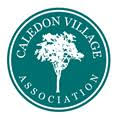HISTORY OF CALEDON VILLAGE
Caledon Village is located north of Brampton and south of Orangeville at the intersection of
Hurontario Street (Hwy. 10) and Charleston Sideroad (Reg. Rd. 24).
The hamlet has been known as Raeburn’s Corners, Charleston, Caledon and lastly Caledon Village.
The survey of Caledon Village was completed in 1820 and a post office was established in 1839 under the name of Charleston. It was renamed in 1853 to Caledon but both names continued to be used for the hamlet and both appeared in the 1877 Historical Atlas. In 1975, the popular and official name of Caledon was changed to Caledon Village to distinguish from the newly created Town of Caledon formed by Regional Government in 1974.
Caledon thrived when the railway was constructed from Owen Sound to Toronto in the 1870s. Grain was shipped from Owen Sound twice daily which brought the mail and enabled passengers to travel to Toronto.
In 1877 records indicate there were 3 blacksmiths, a doctor, a tailor, 2 shoe maker shops, 3 hotels, 2 churches, a common school, an Orange Lodge, 4 drive sheds and 3 general stores which sold just about everything from rubber boots to jewelry.
In the early 1900s, the Rutledge Brothers established the first acetylene gas station to provide gas to light the street lanterns. Electricity followed shortly after WW1. The citizens provided free labour to erect the pole line from the Cataract to the village around 1923.
When the railway was disbanded ca. 1937, Hurontario Street became the main thoroughfare to Owen Sound . It was first paved in 1929 and in 1950/51 the curve and hill was removed south of the village. It was then widened again in 1955, repaved in 1959 and widened again in 2010.
The fire department consisted of 50-60 people forming a bucket brigade but many historical buildings were destroyed by fire, including 3 hotels and Stuckey’s store. The Union Bank of Canada was the first bank in the early 1900s and it then became the Royal Bank in 1920 and despite public protest, was closed in March 1993.
There was a Presbyterian church associated with the cemetery which doubled as the first school. There was also a Methodist church, which was situated south of the former public school. With the union of churches in 1925, Knox Presbyterian church on Charleston built in 1873, became Caledon United church and the Methodist church was no longer required. Bill Stubbs purchased the building, on condition that it was demolished. The bricks from this church were used to build a house for Bill’s parents, to face the Royal Bank building and to build the 20 ft. extension on the rear of the Caledon Township hall in 1935 to accommodate a stage.
The first school was held in the log church constructed in 1828 which was replaced with a brick building in 1876. This school was replaced with a red brick school (SS#8) in 1938 in almost the same location. It has been the home of Caledon OPP and various other commercial enterprises since that time.
Caledon has been the home of the Caledon Fall Fair since 1862 and has been in its present location since the early 1900s. In 1926, the Caledon Agricultural Society purchased 18½ acres through subscriptions, from Thomas Smith and the fair has used these grounds since that time for an annual fair and Caledon Day celebrations.


